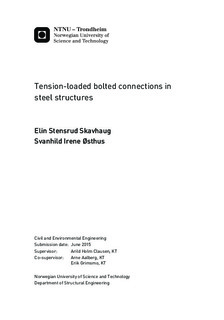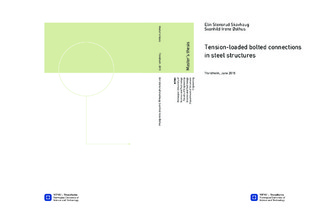| dc.contributor.advisor | Clausen, Arild Holm | |
| dc.contributor.advisor | Aalberg, Arne | |
| dc.contributor.advisor | Grimsmo, Erik | |
| dc.contributor.author | Skavhaug, Elin Stensrud | |
| dc.contributor.author | Østhus, Svanhild Irene | |
| dc.date.accessioned | 2015-10-05T15:17:36Z | |
| dc.date.available | 2015-10-05T15:17:36Z | |
| dc.date.created | 2015-06-19 | |
| dc.date.issued | 2015 | |
| dc.identifier | ntnudaim:13370 | |
| dc.identifier.uri | http://hdl.handle.net/11250/2351426 | |
| dc.description.abstract | The purpose of this thesis is to study the behaviour of bolted steel connections subjected to tension. Quasi-static conditions have been considered. By performing laboratory tests on single bolts and simple T-stub connections the failure modes of the bolts have been examined. Finite element models are created and validated to represent the behaviour observed in the laboratory.
Different grip length configurations have been tested for a single bolt and nut assembly subjected to pure tension. Both partially and fully threaded bolts have been considered. It was found that partially threaded bolts with three threads between the unthreaded part of the shank and the bearing surface of the nut experienced thread stripping. This is inconsistent with the recommendations given in NS-EN 1090-2, which states that one full thread is sufficient to avoid thread stripping. Finite element models are able to recreate the behaviour of all configurations tested with acceptable accuracy. In addition to the grip length, the material properties and geometry of the threads are identified as the crucial factors for the failure modes of the bolts.
Simple T-stub connections with one bolt in each flange have been tested to examine the behaviour of the bolts when they are subjected to a combination of tension and bending. The center distance between the bolts was varied to examine the behaviour when subjected to increased bending effects. Connections with partially threaded bolts all failed due to thread stripping. The fully threaded bolts experienced both thread stripping and bolt failure. The complexity of the stress distribution when large bending effects are present was difficult to recreate with a simplified finite element model. Acceptable accuracy up to maximum force was possible to achieve for the smallest bolt center distance. The response of the finite element model was very mesh sensitive, and difficult to recreate with limited computational capacity when applying an explicit solution algorithm. | |
| dc.language | eng | |
| dc.publisher | NTNU | |
| dc.subject | Ingeniørvitenskap og IKT, Konstruksjonsteknikk | |
| dc.subject | Bygg- og miljøteknikk, Beregningsmekanikk | |
| dc.title | Tension-loaded bolted connections in steel structures | |
| dc.type | Master thesis | |
| dc.source.pagenumber | 198 | |

